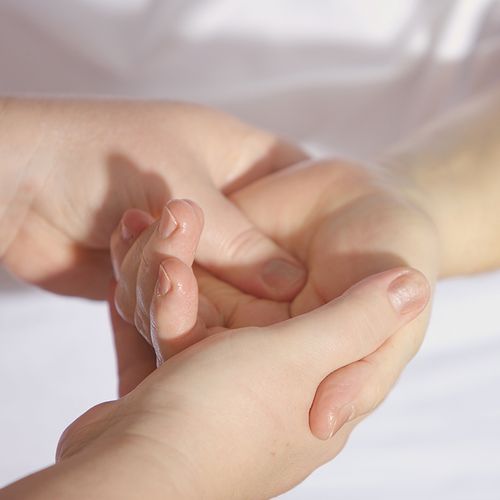Most forms of massage are administered by a massage therapist. But do-it-yourself massage can help ease a variety of health problems ranging from pain due to arthritis and headaches to digestive complaints, fatigue, insomnia and urinary frequency.
One highly effective system of self-massage is included in traditional Chinese medicine (TCM). According to TCM, when a person is unwell or injured, or when one of his/her organ systems, such as the digestive tract, is not functioning optimally, small areas of soreness called trigger points appear on the body.
There can be anywhere from three to 10 trigger points for each ailment. Trigger points are located at problem areas and at "reflexes," points that are a distance away from problem areas and connected through the nervous system. Massaging trigger points can be highly effective at easing symptoms.
In addition to targeting trigger points, massage causes us to relax, which helps the endocrine glands produce body-healing hormones and allows more oxygen to be delivered to the body as blood vessels expand. Massage also enhances the lymphatic system, which helps remove waste products from our bodies while fortifying the immune system.
Self-massage can work for prevention, too. For example, kneading the toes and tops of the feet may prevent an oncoming headache.
Although the hands, feet, ears and abdomen are associated with specific ailments, it's wise to self-massage all of these parts of the body from time to time to search for any tender spots. This is your body's signal that you should focus on those areas.
Fully massaging your hands, feet, ears or abdomen is considered a "session" and takes about 10 minutes. People in generally good health should aim for one session a day. Those with a more serious health problem, such as cancer, diabetes or heart disease, can (with a doctor's OK) try it twice daily. How to practice self-massage…
Hands
In TCM, tender spots around the edges of your palm, closer to the fingers than the heel of the hand, are generally associated with problems in your upper body, including your heart, lungs or throat. Tenderness toward the heel of the hand usually signals a problem in the lower body, such as the hips, legs or pelvis.
What to do: With your left hand palm up, start at the upper-left corner of your palm and rub across with your right thumb, applying pressure at numerous points. Start with light pressure and gradually use more force. While using the right thumb in the palm of the left hand, massage the back side of the left hand with the fingers of the right hand. Squeeze your left hand with firm (but not painful pressure. If you find areas of soreness, hold firmly for 10 seconds, then release. Repeat the self-manage five times. Massage cach finger from palm to nail, then work on the other hand.
Success story: Richard, a 72-year-old golfer who had arthritis in his hands, not only eased his arthritis pain but also reduced his urinary frequency after practicing self-massage on his hands.
Feet
The toes and tops of the feet are associated with the upper body (head, eyes, neck and shoulders), according to TCM. The middle part of the foot is linked to the torso (kidneys and stomach), while the heels and bottoms of the feet correspond to the lower body (bladder and small and large intestines).
What to do: While holding your foot with your opposite hand, apply pressure and move the thumb of the other hand along the entire bottom of the foot. Start by moving across 7 the top of the foot, including the toes, down toward the middle of the foot and then back to the bottom of the foot (usually the primary focus). Note areas of tenderness, and return to them a second or third time. Repeat on the other foot. If it's easier for you, place a golf ball or rolling pin on the floor and roll your foot over it to access any tender spots on the bottom of your foot.
Success story: Sandy, a 56-year-old woman who had migraines, discovered through trial and error that her areas of soreness were located in the middle of the foot between the first and second toes. By doing foot massage for four to five minutes per foot twice daily, Sandy reduced the frequency and severity of her migraines. Such results typically last a few days.
Ears
In TCM, the earlobes are related to the upper body (head and sinuses, for example), while the tops of the ears are linked to the lower body (low back, hips, legs and feet).
What to do: Use moderate pressure and work over the entire ear, both the is inner part (against the skull and the outer part (along the edges) using a kneading motion between the thumbs and forefingers. It's fine to work on both ears simultaneously.
Success story: Eileen, a 60-year-old piano teacher with urinary urgency, discovered that massaging the tops of her ears helped reduce the bladder spasms that made her urinate. In TCM, the upper-inner rim of the ear corresponds to the bladder.
Abdomen
The abdomen is primarily associated with gastrointestinal functions (such as digestion and bowel movements), according to TCM.
What to do: While sitting or lying down, place one hand on top of the other and move them in a circular clockwise motion around the abdominal area. Start below the breastbone, moving the hands to the top-left edge of the rib cage, down to the left corner of the pelvis and across the pubic bone. Then move the hands to the right corner of the pelvis, up to the top-right edge of the rib cage and back to below the breastbone.
Success story: Margie, a 65-year-old woman who had severe left hip pain, discovered a painful area on the left side of her abdomen near the ribs. Regularly massaging this and other points around the abdomen has decreased the intensity of her distant hip pain. She has remained pain-free for several years.
